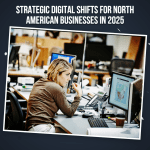The digital marketing environment in North America is entering a critical phase in 2025. Rapid advances in technology, evolving consumer expectations, and the expansion of digital platforms are reshaping how organizations compete. Businesses that position themselves strategically in response to these shifts will be better placed to secure growth, maintain customer loyalty, and strengthen long-term resilience.
This analysis examines the most important digital marketing developments for 2025, outlining where investments of time and resources can create measurable advantages.
Artificial Intelligence as a Core Business Asset
Artificial intelligence has moved from being an experimental tool to an operational necessity. In 2025, it is not a question of whether AI will influence marketing, but rather how deeply it will integrate into the strategic framework of competitive organizations.
Businesses are applying AI to optimize content creation, automate customer service, and deliver highly targeted campaigns. AI-driven systems can draft effective marketing copy, analyze customer sentiment in real time, and identify emerging market trends faster than human teams.
For North American businesses, the value proposition of AI is twofold. It reduces inefficiencies by automating repetitive processes, and it enhances decision-making by delivering insights based on robust data analysis. Organizations that delay integration risk conceding market share to competitors who are already leveraging AI to lower costs and increase engagement.
Precision Through Personalization
The ability to personalize at scale is now a decisive factor in building customer loyalty. Modern consumers expect tailored communication, whether through promotional emails, targeted recommendations, or customized experiences based on purchase history.
North American businesses have access to unprecedented volumes of customer data. The strategic challenge is to transform that information into relevant and timely outreach. A personalized message delivered at the right moment not only secures immediate sales but also fosters long-term trust.
Personalization is no longer an enhancement to traditional campaigns. It has become a structural element of customer relationship management. Companies that execute effectively in this area distinguish themselves from competitors offering generic messaging.
Short-Form Video as the Dominant Communication Medium
The shift toward short-form video represents one of the most significant changes in consumer behavior. Platforms such as TikTok, Instagram Reels, and YouTube Shorts have established themselves as central arenas for attention and engagement.
For businesses, the implications are considerable. Short, visually compelling content drives discovery and expands reach far more effectively than static images or text alone. Importantly, this trend is not confined to large brands with high production budgets. Small and medium enterprises can achieve measurable results with authentic, low-cost videos that highlight their products, services, or company culture.
In strategic terms, short-form video should no longer be treated as experimental. It is a core medium of communication that allows organizations to connect with customers in real time and on a platform of their choosing.
Interactive Content as a Mechanism for Engagement
Engagement in 2025 is defined by participation. Customers do not merely consume information; they expect to interact with brands. Businesses that facilitate this interaction through polls, quizzes, surveys, and feedback loops are better equipped to create memorable experiences.
Interactive content offers two significant benefits. First, it strengthens customer recall by encouraging active involvement. Second, it produces data that can be used to refine future campaigns and product development strategies.
Organizations that prioritize two-way communication position themselves as adaptive and responsive. This approach elevates the brand experience from transactional to relational, which in turn enhances customer loyalty.
Multi-Channel Consistency and Cohesion
The path to purchase has become fragmented across multiple platforms. A customer may first encounter a brand on social media, research through email or online reviews, and complete a transaction on a website or app. Each of these touchpoints must feel consistent for the brand to maintain authority.
Consistency across channels requires disciplined alignment of voice, messaging, and design standards. Disjointed or contradictory communication undermines credibility. Conversely, cohesive integration builds trust and accelerates conversions.
In 2025, businesses that fail to deliver unified experiences risk confusing their audience. Those that achieve brand cohesion will create clear competitive differentiation in crowded markets.
Responsible Branding and Values-Based Loyalty
Corporate responsibility has shifted from being optional to being essential. Customers, particularly younger demographics, are making purchasing decisions based on a brand’s values and commitments. Transparency in areas such as sustainability, ethical sourcing, and community involvement has become a determinant of loyalty.
In this environment, it is no longer sufficient to market products or services alone. Companies must also articulate what they stand for and demonstrate how those principles guide business operations. Organizations that integrate values-based initiatives into their brand narrative are more likely to foster durable loyalty and withstand reputational challenges.
The strategic importance of responsibility is clear. Values-driven branding not only supports customer acquisition but also strengthens resilience in an environment where public scrutiny is constant.
Preparing for Voice Search and Conversational Discovery
The adoption of voice-enabled search is accelerating across North America. Consumers increasingly use smart speakers and mobile voice assistants to search for local businesses, products, and services. This shift requires organizations to adapt their strategies for discoverability.
Optimizing for voice search involves using natural, conversational language in digital content and ensuring that business listings are accurate and complete. Structured data, simplified phrasing, and readily accessible information are essential for capturing voice-based queries.
The growth of voice search is not a passing trend. It is a structural transformation in how customers access information. Organizations that prepare for this change now will benefit from early visibility in an emerging channel of discovery.
Integrating Trends Into Strategic Planning
The trends shaping digital marketing in 2025 are interconnected. Artificial intelligence enhances personalization. Short-form video amplifies brand storytelling. Interactive content deepens engagement. Multi-channel consistency builds trust. Values-based branding drives loyalty. Voice search optimization secures future visibility.
What sets leading organizations apart is not the number of trends they adopt, but how effectively they align these elements with broader strategic objectives. Businesses that view these developments as isolated tactics will struggle to achieve measurable impact. Those that integrate them into a unified framework will strengthen both customer relationships and operational performance.
The digital marketplace of 2025 demands clarity of vision, disciplined execution, and a commitment to adaptation. North American businesses that embrace these shifts strategically will be well positioned not only to compete but to lead in an increasingly complex environment.









